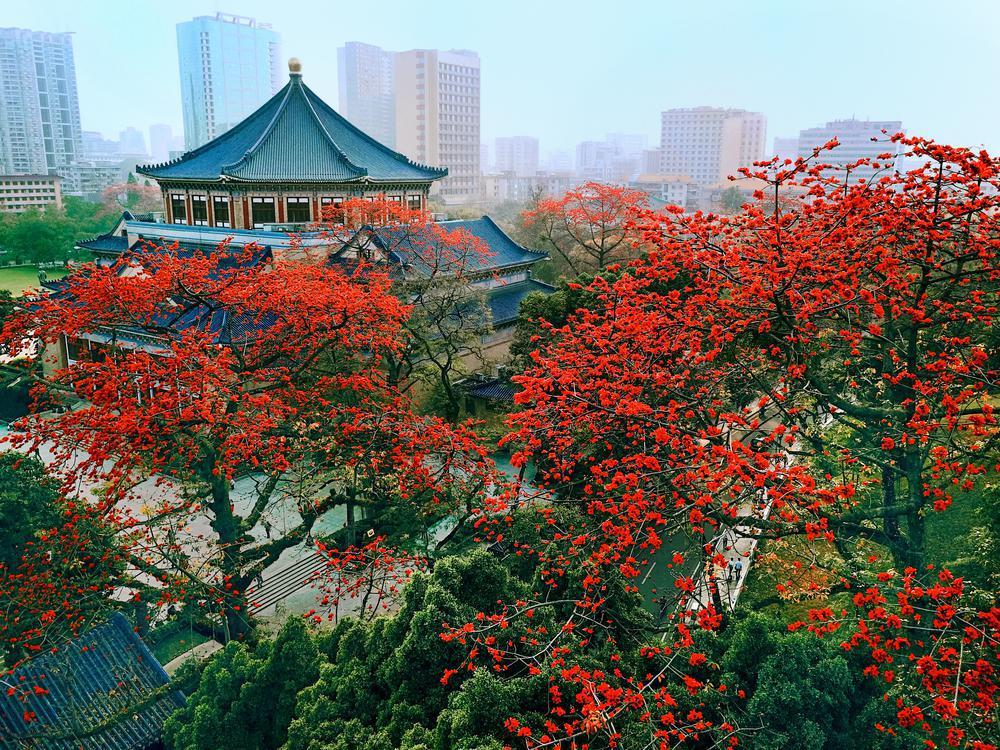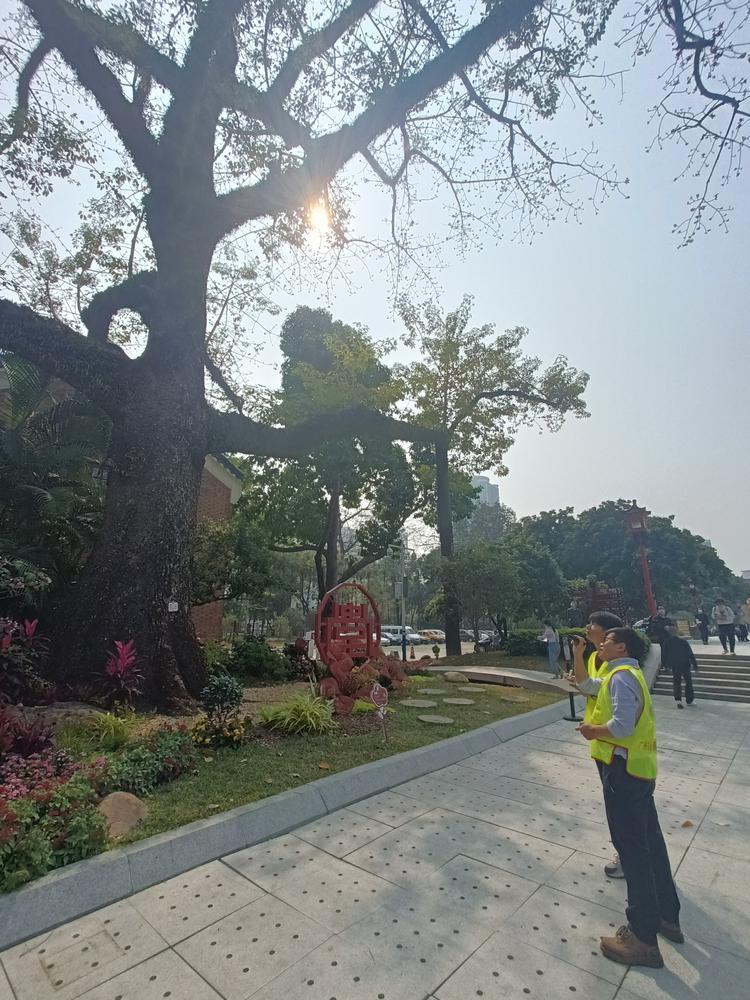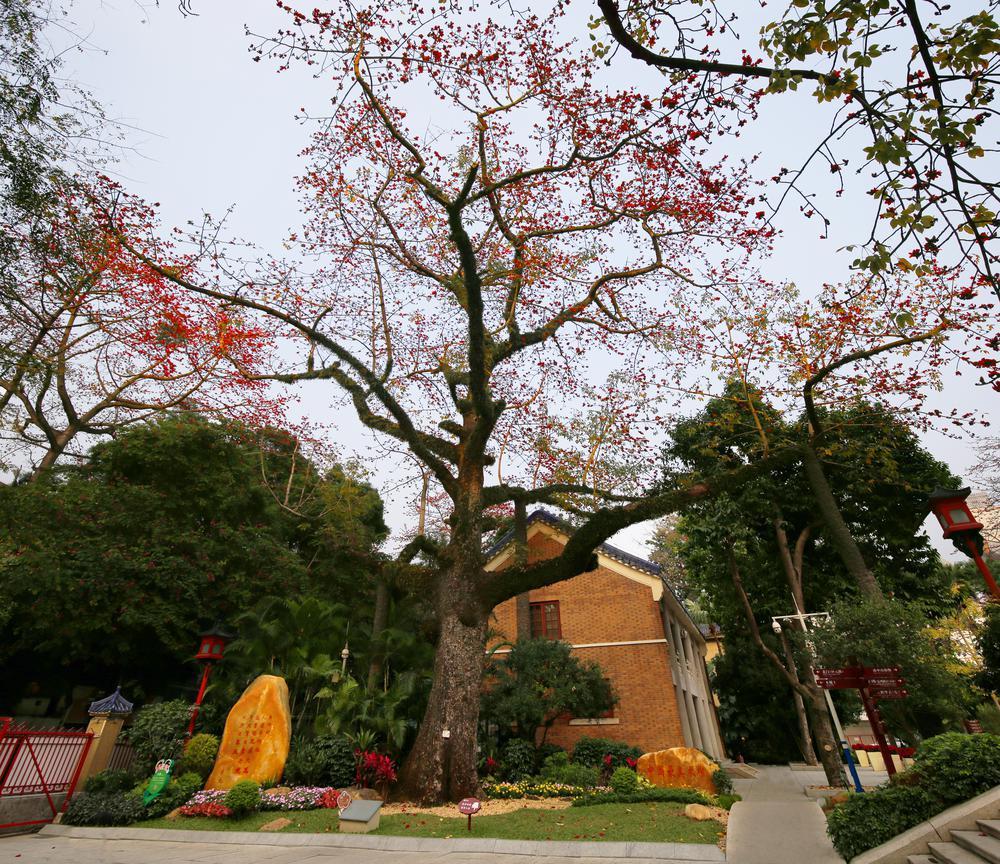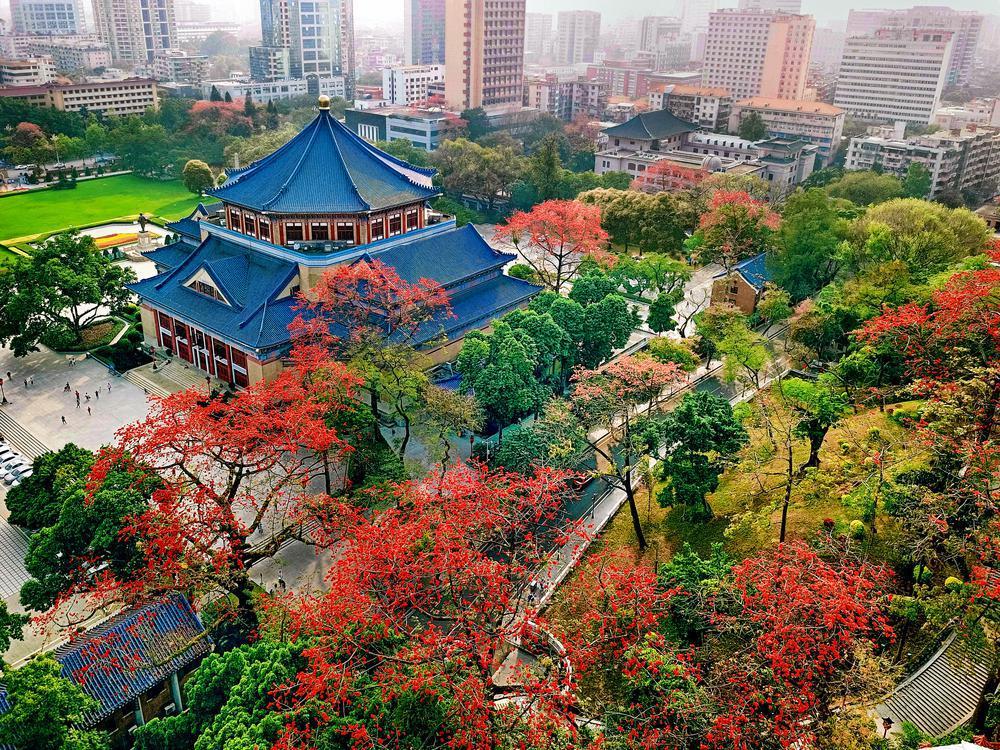
Nestled within the Sun Yat-sen Memorial Hall stands a kapok tree known as the "kapok king". This venerable kapok tree, dating back to around 1669, towers at approximately 27 meters and boasts a storied existence of over 350 years. Standing near theYuewangtai,one of the Eight Ancient Scenic Spots of Yangcheng (Guangzhou) during the Qing Dynasty, it is the earliest witness to the history of the eight ancient kapok trees in the Qing Dynasty, and has been listed as an ancient tree in 1985.
As the years unfold, the "kapok king" remains resolutely upright. Each March, it blooms with an exuberant display of over 80,000 buds, painting the sky with a vibrant red hue. This spectacle attracts countless citizens and tourists alike, who come to admire and capture its beauty in all its glory.

Safeguarding the health of the "kapok king" through biological control
As the esteemed "elderly star" of Sun Yat-sen Memorial Hall, the preservation of the "kapok king" is paramount. Longhorn beetles, a notorious menace to kapok trees, have posed a persistent challenge. Therefore, in 2019, experts introduced an innovative biological control method to counter these pests, employing the principle of "using insects to control insects." This involved introducing Dastarcus helophoroides larvae, a natural predator of longhorn beetles, as a biological solution.
Reports indicate that during the initial stages of the longhorn beetle infestation each year, plant protection workers would release a designated number of Dastarcus helophoroides larvae onto the trunk of the "kapok king." These larvae effectively combat the longhorn beetles through external parasitism, eliminating the threat. Since the implementation of this technique, the "kapok king" has remained resilient, unscathed by similar pests.

Balancing the preservation of ancient trees and architectural heritage
Just a few meters away from the main trunk of the "kapok king" stands the east annex of a cultural heritage building. Over the years, the "kapok king" has flourished, with one of its eastern branches extending almost to the roof of the annex. To balance the growth of the tree with the preservation of the cultural heritage building, in 2019, the management of the memorial hall installed three large support columns for the risky parts of the "kapok king."

Besides, in 2021, the memorial hall introduced a set of fully automatic termite monitoring equipment, with 331 devices placed throughout the park, including four around the "kapok king," providing round-the-clock vigilance. Once a termite infestation is detected, it alerts the management through their mobile phones, solving the pest problem in its infancy. This innovative approach provides more long-term and reliable protection for both the ancient trees and the cultural heritage buildings.
Ancient tree in Alipay Ant Forest
InJune 2023, the Guangzhou Municipal Forestry and Landscaping Bureau and Alipay Ant Forest jointly announced the launch of the "Guangzhou Ancient and Famous Trees Protection Public Welfare Support Project" at Sun Yat-sen Memorial Hall in Guangzhou. This innovative initiative harnesses the power of Alipay Ant Forest, enabling citizens to contribute to the preservation of Guangzhou's ancient and famous trees by leveraging the energy accumulated through their low-carbon lifestyles.
Immediately after being added to Alipay Ant Forest, the "kapok king" received online protection from one million people. Thanks to this collective care, the venerable tree remains vibrant and blossoms with 80,000 buds every year.
Blooming vigorously every spring is a promise made by the "kapok king" and a testament to the enduring charm of Guangzhou. In the nationwide selection event for "China's Most Beautiful Ancient Trees" organized in 2018, the "kapok king" was honored with the title of "China's Most Beautiful Kapok",emerging as a representative of kapok varieties nationwide. In 2022, the "kapok king" was exhibited as a representative of the cultural value of ancient trees in the "China Ancient and Valuable Tree Protection Photo Exhibition," alongside the Guest-Welcoming Pine of Huangshan Mountain.

Source: Yangcheng Evening News
岁岁如约,广州中山纪念堂“木棉王”8万花苞传芳华
中山纪念堂内有一株被称为“木棉王”的木棉树。这株栽植于1669年前后的古树,高约27米,如今已有350余岁高龄。它位于清代羊城古八景中的越王台附近,是清代羊城古木棉八景中最古老的见证者,于1985年被鉴定为古树。
时光荏苒,“木棉王”仍傲然挺立。每年3月,满树繁花如约而至,8万余朵花苞在高空铺撒一片绵延的鲜红锦绣,吸引了无数市民游客前来赏花打卡。

“以虫治虫”守卫健康
“木棉王”作为中山纪念堂的“老寿星”,保持健康是头等大事。天牛类害虫是木棉常见的虫害之一。2019年,专家对“木棉王”引进了病虫害生物防治新技术,即“以虫治虫”,将天牛类害虫的天敌——花绒寄甲幼虫作为“解药”。
据介绍,每年天牛类害虫发生前期,植保工作者会在“木棉王”树身施放一定数量的花绒寄甲幼虫,这些幼虫会通过体外寄生形式杀死天牛类害虫。自实施该项技术以来,“木棉王”未再发生类似虫害。
古树古建筑两手抓
在“木棉王”主树干五六米开外,便是一座文物建筑东附楼,随着木棉王逐年长大,其东侧一根枝条几乎横跨东附楼的屋面。为了协调树木生长和文物建筑保护,2019年,纪念堂管理人员为“木棉王”风险部位修建了三条巨大的支撑柱。
2021年,纪念堂引进了一套白蚁全自动监测设备装置,在全园共埋设331个,其中“木棉王”周边4个。这套装置能24小时不间断工作,一旦发现白蚁危害,就会在管理人员的手机端进行警示,掐断蚁害的苗头,为古树老树和文物建筑提供更长效可靠的保护。
古树搬进“蚂蚁森林”
2023年6月,广州市林业和园林局与蚂蚁森林在广州中山纪念堂联合宣布启动“广州市古树名木保护公益支持项目”。市民通过支付宝“蚂蚁森林”,用低碳生活积攒的能量支持广州古树名木的保护工作。
“木棉王”一上线就获得了100万人的线上守护。有赖于大家的精心呵护,“木棉王”得以活力四射,保持着每年8万朵花苞的生长态势。
逢春必怒放,是“木棉王”的承诺,更是广州不变的芳华。在2018年全国范围组织开展的“中国最美古树”遴选活动中,“木棉王”荣获了“中国最美木棉”称号,是全国木棉品种的代表。2022年在《中国古树名木保护图片展》中,木棉王作为古树文化价值的代表,和黄山迎客松一并展出。
总统筹|林洁 林如敏 林兆均 郑华如 黄丽娜
策划|刘云
统筹|罗仕 王敏
文|记者 孙牧 刘云 实习生 唐青雪 通讯员 刘慧鹏
图|受访方提供
翻译|史洋溢
-
Guangzhou's cross-border e-commerce has surged 136-fold in 9 years
2024-03-14 22:18:13 -
'Kapok king' at Guangzhou Sun Yat-sen Memorial Hall exhibits its splendor with 80,000 buds every year
2024-03-14 22:18:34 -
Over 3000 positions await! Overseas Returnees Career Fair (Spring) to be held in Shenzhen around April
2024-03-14 22:18:56 -
Y Talk 59|Banning TikTok Reflects US's Insecurity 封禁TikTok暴露的美国的不安全感觉
2024-03-14 22:19:52






